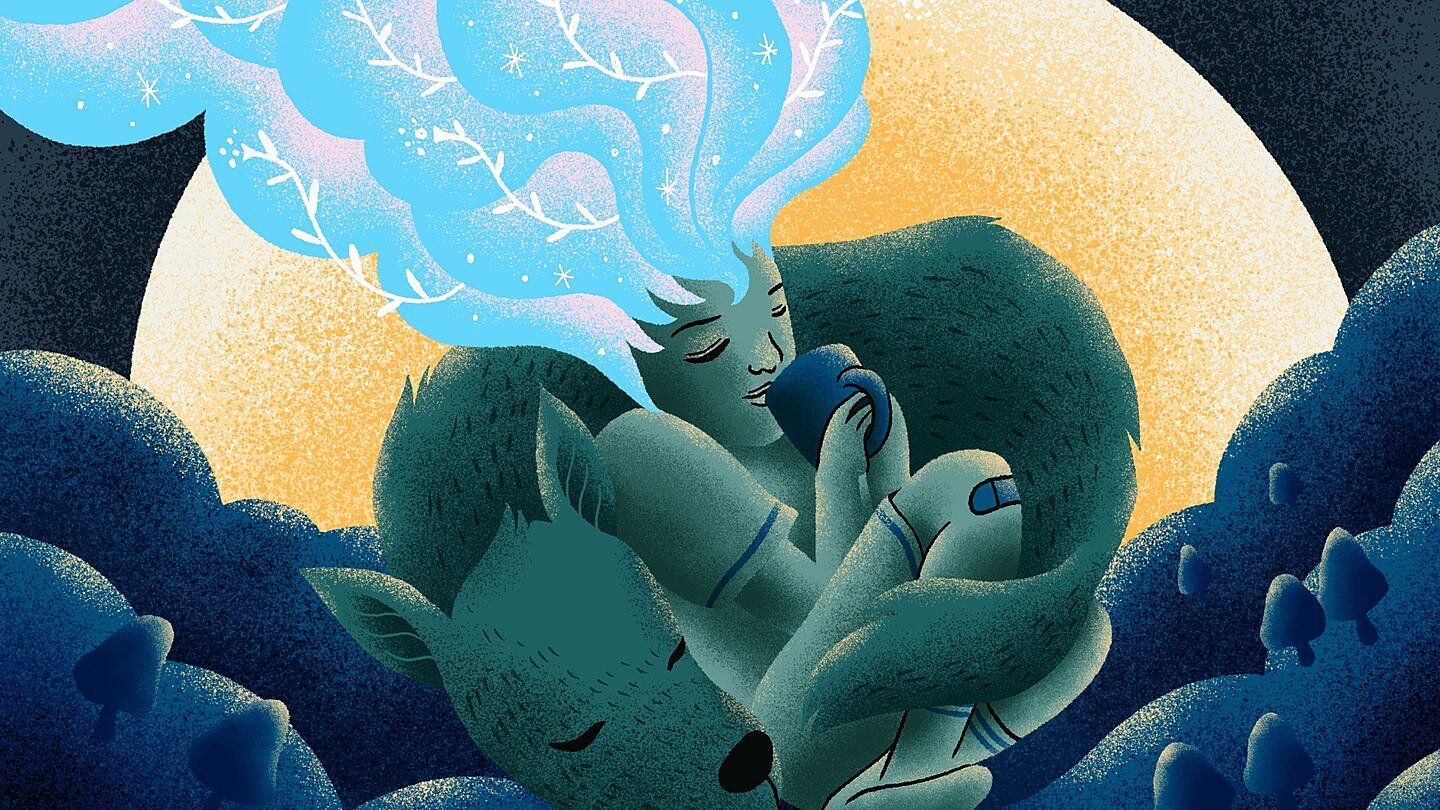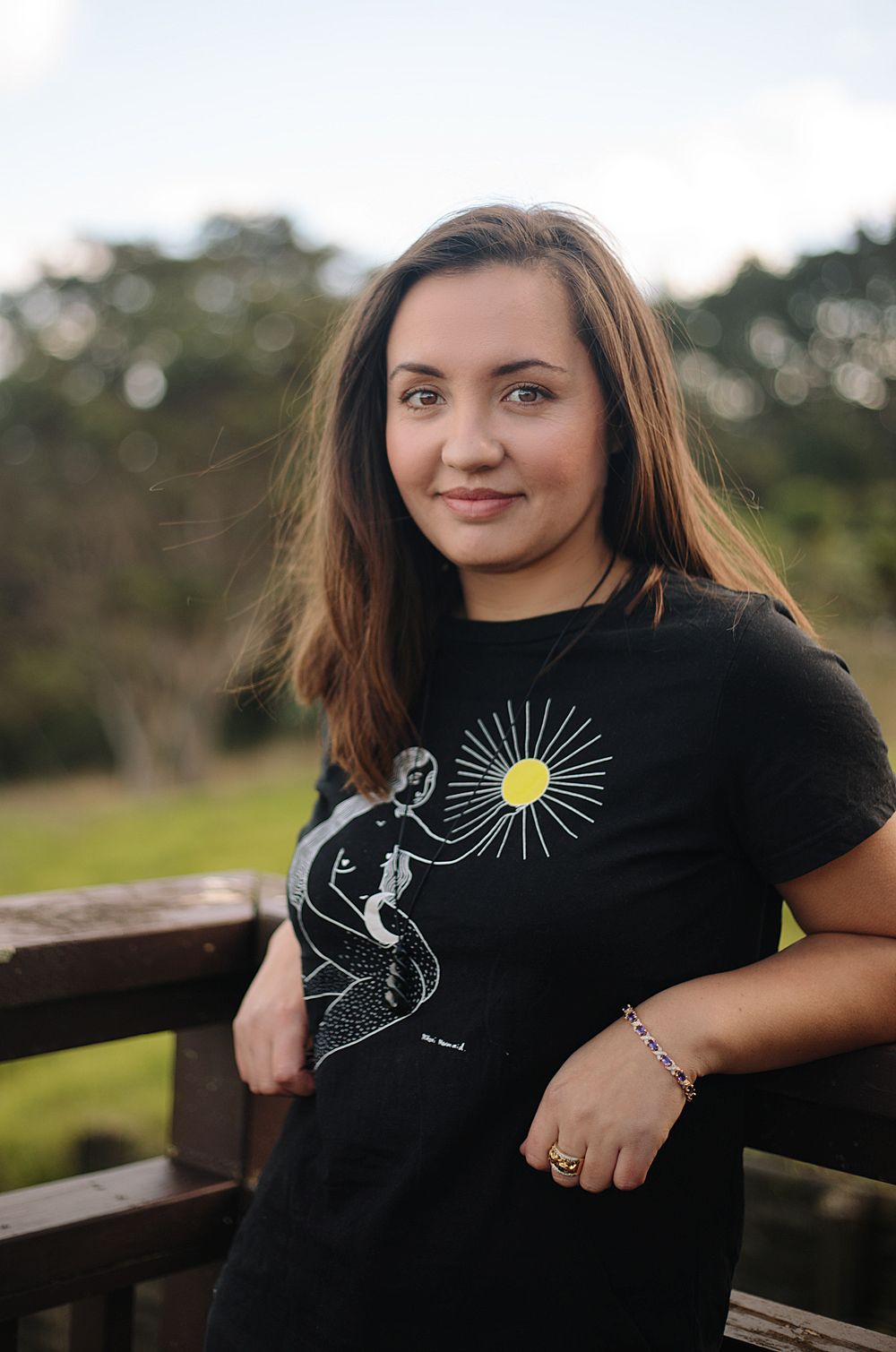Inhale | Exhale
Ataria Sharman, Editor of The Pantograph Punch asks where the joy is in the arts, and whether we’re off balance between the inhale and the exhale.
I wasn’t sure where to start with the Editor’s letter for Inhale | Exhale until we received the illustration from artist Marc Conaco to accompany this bi-monthly issue. When first viewing this work I had an emotional response – welling in my eyes – and I still do even now. Just as the PP whānau have done in the piece ‘What’s Your Inhale | Exhale?’ I again felt I had to reflect and ask myself, what exactly is this illustration (in its entirety) touching in me?
Sherry Zhang came up with the idea of Inhale | Exhale at our team editorial hui, and since then, we’ve interpreted the kaupapa as representing two parts of the creative cycle. The inhale is the artist moving beyond Te Kore Formless Potential in planting the seeds of inspiration into Te Pō. In the artwork, I see this as the slightly darkened slopes of Papatūānuku, with the seeds, the growing mushrooms. In a poem Ilham Akhlaqi wrote for Inhale | Exhale she refers to her home country as a garden, “Afghanistan, being like a garden,” and later on she asks, “Once again when will our country ever-so-blossom?” It feels like right now we are yet again being reminded of the importance for all people to have the right conditions for growth.
What exactly is this illustration (in its entirety) touching in me?
Whiro and Hine Takurua can act as metaphors for this going within, of ‘staying inside’ in some versions of the Maramataka. And the mushrooms here are not growing towards the light of the sun but actually the moon – perhaps a reference to the lunar cycle also intimately connected to women’s cycles. In his kōrero in Siân Torrington’s piece for Inhale | Exhale, Maungarongo Te Kawa connects the atua wahine Hine-Te-Iwaiwa with the “the full, bright, white moon, the energy for midwives, poets, fabric artists and weavers. She’s the energy of growth, a millionth of a second before a flower pops open.” The moon’s light instead of the sun seems an inversion of photosynthesis but, actually, mushrooms grow better in darker conditions than they do in full light.
We see the wahine, or kōtiro, wrapped tightly in the embrace of an oversized kurī. Perhaps a blanket of security, a blanket of warmth while she sips on her tea. And for all of us, the symbolic blanket or ‘blankie’ might literally take form in different things. In romesh dissanayake’s piece on his series of Sri Lankan pop-up dinners, he notes that “a young chef will cherish a knife collection like a childhood blankie. It will bring them great comfort and security, but (like a blankie) it’s weirdly possessive and immature.” It seems that the very tools we wield as creatives can be the blankets that keep us warm.
Why does it have to be so hard all the time? Why isn’t this [insert creative role] the best job in the world? What can we do to enjoy ourselves more, and push ourselves less?
Then from the head comes the clear and bright candy-coloured exhale. It enfolds like billowing waves or expansive clouds, out from the body. It’s apparent that the inhale is intimately connected to the exhale, that we need moments of inhaling as the impulsion for the exhale. Exhale, as we’ve interpreted it, is the artist putting their creations out there for the world to see, and the process of lively experimentation with creativity and sharing of artistic works.
There’s a sense of joy in this artwork. On the face the expression is peaceful, and although they're clearly exhaling, because of the inhale they're in balance. I’ve been having conversations recently with creatives and I’ve even asked myself in this role at The Pantograph Punch, why does it have to be so hard all the time? Why isn’t this [insert creative role] the best job in the world? What can we do to enjoy ourselves more, and push ourselves less?
Nahyeon Lee’s piece on performance artists and the effect of the latest lockdown makes it clear that this is a question we must continue to ask ourselves. In the words of Miria George:
“This time, I felt instantly tired, and I really struggled to get through what would normally be, for any arts practitioner, a long working day. I figured the only way to survive it was to bury my head in creative work.”
To me, this really speaks to one of the biggest issues in the sector. Overwork and underpay. Creatives aren’t getting the opportunity to balance the inhale with the exhale, and that’s stripping the joy out of the creative process. It’s hard to enjoy your creativity and feel a sense of calm when you’re stressed, sick, over-tired and unable to pay your bills.
Looking back to the artwork, there is a dark-blue plaster on the knee. Perhaps it represents that they're taking the time to look after themselves and heal their wounds. They're taking time for the inhale. But is it possible to do so in the ever under-resourced and competitive creative sector? Here at The Pantograph Punch, we’ve more recently been guided by the warmth of the blanket of great leadership, with our Director and Board, where there’s real and deep care for creatives, and even I’ve had pushback when I wanted to do more without proper consideration for the work–life balance of other staff in our organisation. And I’m glad for it!
We all have to be reminded sometimes.
I would like to thank all of our contributors to Inhale I Exhale: Litia Tuiburelevu, Ilham Akhlaqi, Siân Torrington, Kerry Ann Lee, Ashleigh Taupaki, Nahyeon Lee, romesh dissanayake, Janaye Henry, Alesha Ahdar, Tihema Baker, Stacey Kokaua-Balfour, Huni Mancini, Eric-Rangi Hillman, Kahu Kutia and Karen Hu 胡欣宇; and our team at The Pantograph Punch, Lana Lopesi, Sherry Zhang 章雪莉, Ana McAllister, Sinead Overbye, Faith Wilson and our subeditor Marie Shannon.
Nau mai haere mai. Welcome to our imagining of Inhale I Exhale. And this time I don’t hope, I know, you’ll feel awed, inspired and profoundly content with the pieces that we have to offer you in this end-of-September issue of The Pantograph Punch.
Inhale | Exhale
Master Contents
Art
Riding Imperfect Waves: Kerry Ann Lee on Claudia Kogachi’s exhibition There’s No I in Team
Getting Comfortable: On bringing more of ourselves into our art spaces, Siân Torrington with Maungarongo Te Kawa and Zoe Thompson-Moore
Snowballing in the Right Direction: Ashleigh Taupaki and new Ramp gallery curator Hollie Tawhio on future dreaming
Literature
Lying Next to a Cute Li’l Spud: Faith Wilson on why Nostalgia Has Ruined My life is her funniest book of all time
Stories of Pito Planted: Stacey Kokaua-Balfour on Te Kinakina by 12 vaꞌine Kūki ꞌĀirani
Dark Forces of Aotearoa: Tihema Baker reviews Butcherbird by Cassie Hart
Performance
Performing Arts in lockdown: Nahyeon Lee chats to artists about their fears, dreams and visions for the future
Chris Parker Could Stop Tomorrow!: Comedians Janaye Henry and Chris Parker on content creation, lockdown lows and Celebrity Treasure Island
SEELA: romesh dissanayake on the Sri Lankan pop-up dinner series named after his grandmother
Society
For a Brown Girl: Litia Tuiburelevugets a few thoughts on dating and desirability out of her system
Tikanga in War: Ana McAllister on the protocols she uses to protect her tinana and wairua in her activism mahi
Afghanistan, being like a garden: Ilham Akhlaqi asks when her home country will ever get the chance to blossom
Screen
Māori Livestream Gamers: IceKuini and Oldman_shesus, Kai_nine, and Akadjblaze on livestream gaming
He Takatāpui Ahau: Sinead Overbye with Alesha Ahdar, on making a film that the takatāpui community is proud of
Tūmanako: Alesha Ahdar responds to Night Ride, Fifty Percent and Wind Song and Rain in Loading Docs
Music
Kiwi-Asian Musicians: Karen Hu and Sherry Zhang chat with 9 Kiwi-Asian musicians on culture, identity and the music industry
After the Dawn: Huni Mancini and Eric-Rangi Hillman respond to The Panthers soundtrack
Astronesian Futurisms: Kahu Kutia in wānanga with Nahbo on their debut album Ruptured
News
Inhale I Exhale: Letter from Ataria Sharman, Editor of The Pantograph Punch
What’s Your Inhale I Exhale: The Pantograph Punch whānau share moments of inhale and exhale in their creative practices
Off The Beaten Track: Ataria talks to rangatahi Māori Justice Hetaraka on learning on our own history in Aotearoa
Feature image: Marc Conaco

